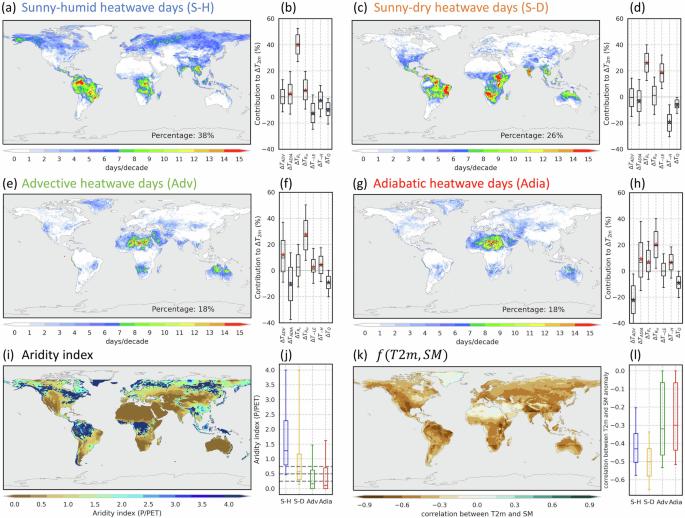Characterizing heatwaves based on land surface energy budget
IF 8.1
1区 地球科学
Q1 ENVIRONMENTAL SCIENCES
引用次数: 0
Abstract
Heat extremes pose pronounced threats to social-ecological systems and are projected to become more intense, frequent, and longer. However, the mechanisms driving heatwaves vary across heatwave types and are not yet fully understood. Here we decompose perturbations in the surface energy budget to categorize global heatwave-days into four distinct types: sunny–humid (38%), sunny-dry (26%), advective (18%), and adiabatic (18%). Notably, sunny-dry heatwave-days decrease net ecosystem carbon uptake by 0.09 gC m−2 day−1 over harvested areas, while advective heatwave-days increase the thermal stress index by 6.20 K in populated regions. In addition, from 2000 to 2020, sunny-dry heatwaves have shown the most widespread increase compared to 1979 to 1999, with 67% of terrestrial areas experiencing a doubling in their occurrence. Our findings highlight the importance of classifying heatwave-days based on their underlying mechanisms, as this can enhance our understanding of heatwaves and improve strategies for heat adaptation. Global heatwave days can be classified into sunny-humid, sunny-dry, advective, and adiabatic types, with sunny-dry days showing the most widespread increase from 2000 to 2020, causing carbon uptake reduction, while advective days increase human thermal stress, according to surface energy budget perturbations analysis.

根据陆地表面能量预算确定热浪特征
极端热浪对社会生态系统构成了明显的威胁,而且预计会变得更加剧烈、频繁和持久。然而,驱动热浪的机制因热浪类型而异,目前尚不完全清楚。在这里,我们分解了地表能量预算的扰动,将全球热浪日分为四种不同类型:晴热潮湿型(38%)、晴热干燥型(26%)、对流型(18%)和绝热型(18%)。值得注意的是,晴朗-干燥热浪日会使收获地区的生态系统净碳吸收量减少 0.09 gC m-2 day-1,而平流热浪日则会使人口稠密地区的热应力指数增加 6.20 K。此外,与 1979 年至 1999 年相比,2000 年至 2020 年期间,晴朗-干燥热浪的增加最为普遍,67% 的陆地地区的热浪发生率增加了一倍。我们的研究结果凸显了根据热浪日的基本机制对其进行分类的重要性,因为这可以加深我们对热浪的理解,并改进热适应战略。根据地表能量收支扰动分析,全球热浪日可分为晴朗潮湿型、晴朗干燥型、对流型和绝热型,其中晴朗干燥型热浪日在2000年至2020年期间增幅最大,导致碳吸收减少,而对流型热浪日则增加了人类的热应力。
本文章由计算机程序翻译,如有差异,请以英文原文为准。
求助全文
约1分钟内获得全文
求助全文
来源期刊

Communications Earth & Environment
Earth and Planetary Sciences-General Earth and Planetary Sciences
CiteScore
8.60
自引率
2.50%
发文量
269
审稿时长
26 weeks
期刊介绍:
Communications Earth & Environment is an open access journal from Nature Portfolio publishing high-quality research, reviews and commentary in all areas of the Earth, environmental and planetary sciences. Research papers published by the journal represent significant advances that bring new insight to a specialized area in Earth science, planetary science or environmental science.
Communications Earth & Environment has a 2-year impact factor of 7.9 (2022 Journal Citation Reports®). Articles published in the journal in 2022 were downloaded 1,412,858 times. Median time from submission to the first editorial decision is 8 days.
 求助内容:
求助内容: 应助结果提醒方式:
应助结果提醒方式:


